Keywords
|
| Smart grid, renewable energy, solar, ac/dc/ac converters, BTB, power electronics, transmission lines, IP address |
INTRODUCTION
|
| A smart grid is an electrical grid that uses information and communications technology to gather and act on information, such as information about the behaviors of suppliers and consumers, in an automated fashion to improve the efficiency, reliability, economics, and sustainability of the production and distribution of electricity. Today’s energy grid has been developed with extensive interconnections and grids often spanning continents. The purpose of this interconnection is to improve reliability through redundancy. However, in some ways, this interconnection increases the risk of wide area failures because any imbalance can be propagated quickly over an ever widening area. Increasing proportions of renewable and variable energy generation because increasing fluctuations which will become, at some point, unmanageable use the current grid architecture. If we can envision a future world where higher penetration of renewable energy is expected, we can also forecast new ways to use electricity that are not possible with the current grid design. In order to accept increasing penetration of renewable energy into the current power grid, it is important to measure power. |
| This paper describes the “digital grid” where a wide-area synchronized power system is subdivided (“digitalized”) into smaller or medium sized power systems [1] |
| A. Renewable Energy Potential in India. |
| Renewable energy can make a substantial contribution in each of the above mentioned areas. It is in this context that the role of renewable energy needs to be seen. It is no longer “alternate energy”, but is increasingly becoming a vital part of the solution to the nation’s energy needs. In terms of all renewable energy categories, India is currently ranked fifth in the world with 15,691.4 MW grid-connected and 367.9 MW off-grid renewable-energy based power capacity. India is among the top five destinations worldwide for solar energy development according to Ernst & Young’s renewable energy attractiveness index. |
| Solar power has so far played an almost non-existent role in the Indian energy mix. The grid-connected capacity in the country now stands at 481.48 MW, while the total solar energy potential has been estimated at 50,000 MW.[2] |
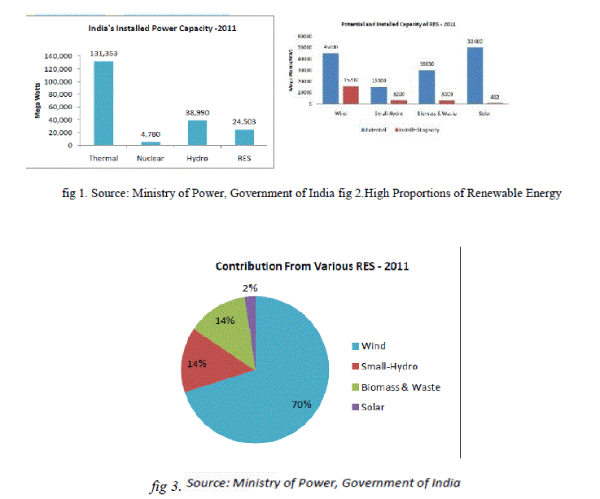 |
| India is densely populated and has high solar isolation, an ideal combination for using solar power in India. Much of the country does not have an electrical grid, so one of the first applications of solar power has been for water pumping; to begin replacing India's four to five million diesel powered water pumps, each consuming about 3.5 kilowatts, and off-grid lighting. Some large projects have been proposed, and a 35,000 km² area of the Desert has been set aside for solar power projects, sufficient to generate 700 to 2,100 gig watts. |
| The Indian Solar Loan Programmed, supported by the United Nations Environment Programme has won the prestigious Energy Globe World award for Sustainability for helping to establish a consumer financing program for solar home power systems. Over the span of three years more than 16,000 solar home systems have been financed through 2,000 bank branches, particularly in rural areas of South India where the electricity grid does not yet extend. |
| Launched in 2003, the Indian Solar Loan Programmed was a four-year partnership between UNEP, the UNEP Risoe Centre, and two of India's largest banks, the Canara Bank and Syndicate Bank |
| Announced in November 2009, the Government of India proposed to launch its Jawaharlal Nehru National Solar Mission under the National Action Plan on Climate Change with plans to generate 1,000 MW of power by 2013 and up to 20,000 MW grid-based solar power, 2,000 MW of off-grid solar power and cover 20 million sq meters with collectors by the end of the final phase of the mission in 2020. Wind Energy |
| The development of wind power in India began in the 1990’s, and has progressed steadily in the last few years. The short gestation periods for installing wind turbines, and the increasing reliability and performance of wind energy machines have made wind power a favored choice for capacity addition in India. The country’s total wind energy potential has been estimated at 45,000 MW. The wind energy sector has seen significant investments spurred by the development potential, availability of wind farm equipment at competitive prices, and conducive government policies. Currently, wind power accounts for around 70 percent of the installed generation capacity from renewable sources. Presently, India (15,700 MW) is in fifth position, following China (44,733 MW), the US (40,180 MW), Germany (27,215 MW) and Spain (20,676 MW). Wind power accounts for nearly 8 percent of India’s total installed power capacity. |
Small-Hydro Energy
|
| In India, hydro power projects with station capacity of up to 25 MW fall under the category of small hydro power (SHP). The total installed capacity of small hydro power projects as on March 31, 2012, was 3200 MW. However, the estimated potential for power generation from such plants is over 15,000 MW. Most of the latent potential is in the Himalayan states - as river-based projects - and in the other states as irrigation canal-based projects. The SHP programmer is largely private investment driven. Since the projects are economically viable, the private sector is keen on investing in SHP projects. The viability of these projects improves with increase in the project capacity. |
Biomass & Waste Energy
|
| India’s climatic conditions offer an ideal environment for biomass production. Biomass gasification is emerging as a method of power production that holds significant social and business benefits. In fact, bio-energy has remained critical to India’s energy mix, with a total installed capacity of 3000 MW. The total biomass & waste energy potential in India has been estimated at over 30,000 MW. Biomass gasification based power production is able to generate power on small scales and offers a solution for producing off-grid green power Owing to its virtues, biomass gasification in India could play a key role in the electrification of rural and remote communities Indian industries could start using biomass gasification for power generation, replacing more costly heating options such as furnace oil India has an estimated potential of over 30,000 MW of power from biomass, but around 3000 MW has been exploited. Thus, over 90 percent of potential capacity lays untapped [2] [3] |
NEED OF SMART GRID
|
| In recent years, electric power generation from renewable energy sources such as wind and solar has accelerated due to efforts to reduce the impact of climate change and increasing fossil fuel prices. Increasing proportions of renewable and variable energy generation cause increasing fluctuations |
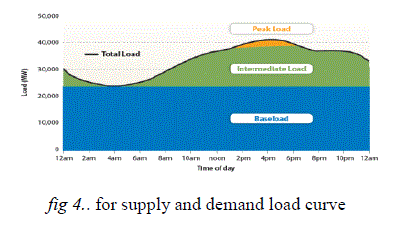 |
| Different types of electricity users demand power in different amounts and at different times; this results in a load curve that varies by time-of-day and season |
| “An automated, widely distributed energy delivery network characterized by a two-way flow of electricity and information, capable of monitoring and responding to changes in everything from power plants to customer preferences to individual appliances.” |
| “An electricity delivery system (from point of generation to point of consumption) integrated with communications and information technology.” |
Present Scenario of Power system….. (In INDIA)..
|
| India’s Smart Grid policy is an emerging part of its nationwide energy policy. The policy is being jointly developed by a collaborative grouping of central and state governmental bodies and subject matter experts from industry, academia and non-governmental research and development organizations. The chronology and lineage of legislative efforts, programs and associated schemes which have led up to the development of a Indian Smart Grid originate with a fundamental shift towards private involvement in energy production and transmission and the unbundling of the power sector from total government control in the 1990s. Government’s desire to formulate a scheme to encourage greater use of ICT to enable India’s electric grid by make three fundamental improvements to the existing grid: |
| • Advanced metering to reduce AT&C (Aggregate Technical and Commercial) losses that are at an unacceptably high-level presently; |
| • Automation to measure and control the flow of power to/from consumers on a near real-time basis and improve the system reliability; |
| • Moving to a smart grid to intelligently manage loads, congestion and shortfall. |
| Other important changes in energy laws including the Electricity Act of 2003 and the important National Electricity Policy of 2005 have set forth a formative set of national energy objectives including: |
| • Access to Electricity - Available for all households in next five years |
| • Availability of Power - Demand to be fully met by 2012. Energy and peaking shortages to be overcome and adequate spinning reserve to be available. |
| • Supply of Reliable and Quality Power of specified standards in an efficient manner and at reasonable rates. |
| • Per capita availability of electricity to be increased to over 1000 units by 2012. |
| • Minimum lifeline consumption of 1 unit/household/day as a merit good by year 2012. |
| • Financial Turnaround and Commercial Viability of Electricity Sector. |
| • Protection of consumers’ interests[2][4] |
Goal of Modernization of Indian Grid System
|
| • Renovation and modernization (R&M) of power plants |
| • Strengthening and improvement of sub-transmission and distribution networks |
| • Development of adequate spinning reserves |
| • Development of power systems automated controls |
| • End of Load Sharing- peak load shifting through a combination of direct control and differential pricing (demand response/dynamic (DSM)) |
| • Reliable Power- Robust systems with Self-healing capabilities through monitoring |
| • Cheaper Power- Dramatic improvement in AT&C losses, real time monitoring load sources |
| • Shifting the Peak away from Costly Power- Better utilization of Assets |
| • More Sustainable Power- Integration of green and renewable resources at a massive scale, enough to increase energy independence |
Modern Grid System
|
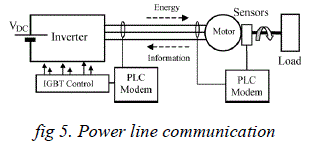 |
| THE POWER LINE communication (PLC) technology allows us to transmit control and diagnostic information’s (temperature monitoring, vibrations measurements) measured by sensors back to the power converter where they will be treated using the power cable as a communication medium. The main advantage is that we avoid the use of a separated signaling cable that needs permanent maintenance and may cost up to few thousand dollars per meter installed in an industrial environment [5]. Fig. 1 presents an example of an experimental setup where the rotor speed is sent back to the power converter through the power cable using the PLC technology. This technology already exists in domestic application and allows data transfer at high throughput via the electrical network [6],[7]. The PLC modem based on the Home Plug technology modulates the information signal with orthogonal frequency-division multiplexing (OFDM) , sends it through the electrical cable and superposes it to the electrical signal. At the reception point, a filtering process followed by a demodulation permits to recuperate the data. It can be used for video communicating, sharing files, and common internet applications such as e-mailing and chatting. In a similar way, we will explore this technology in an industrial environment, where we can use the motor power cable, not only for power delivery, but also for communication purpose . For example, this technology can be used for monitoring an inverter-fed induction machine by transmitting the online winding temperature through the power cable . The feeder cable can also be used as a feedback channel for an encoder signal in the real-time servo system or induction motor control applications. The currently used PLC modems in the domestic application based on Home Plug are conceived for high data rate communication in electrical network by being superposed to the sinusoidal power signal. However, in industrial applications, the power signal generated by the inverter is different in terms of amplitude and frequency. Domestic power line modems may not work correctly in such applications. Hence, a full study needs to be carried out in mean to study the possibility to communicate in such environment and the limitations that may obstruct us. Note that many papers have studied the issue of modeling power line cables where shielded cable has been used as a communication medium. Therefore, we focus in this paper on studying the inverter’s effect on the communication reliability. .[7][9] |
SMART METERING SYSTEM
|
| Availability Based Tariff (Advanced Metering system for digital grid) |
| What Is ABT? |
| • It is a performance-based tariff for the supply of electricity by generators owned and controlled by the central government |
| • It is also a new system of scheduling and dispatch, which requires both generators and beneficiaries to commit to day-ahead schedules. |
| • It is a system of rewards and penalties seeking to enforce day ahead pre-committed schedules, though variations are permitted if notified One and one half hours in advance. |
| • The order emphasizes prompt payment of dues. Non-payment of prescribed charges will be liable for appropriate action under sections 44 and 45 of the ERC Act.[10] |
| Why ABT? |
| 1. India plans to have an integrated National Grid. This will assist in meeting demand with the least cost supply. Five Regional grids already exist. Some linkages between Regions are also in place. |
| 1. The five Regional grids work at vastly varying operational parameters today. Frequency level is one such operational parameter. The target frequency prescribed by the Indian Electricity Rules is 50 Hz |
| 2. Integrated grid operations require the normalization of frequency across all five Regions. The alternative is to insulate each Regional Grid by Back to Back HVDC links. This is an expensive option. Normalization of frequency requires proactive load management by beneficiaries and dispatch discipline by generators. |
| 3. There is currently no formal system of financial incentives to promote grid discipline. |
| 4. The ABT provides this mechanism. |
| 2. Chronic surpluses in the East and shortages in the South have resulted in sustained functioning of these grids at frequencies which are far beyond even the normal band, liberally defined by the IEGC as frequency variation within 49.5 to 50.3 Hz. |
| 1. Continued functioning at non-standard frequency results in long-term damages to both generation and end use equipment this is a “hidden cost” which is borne by the customer in the long term. |
| 2. The ABT will induce corrections in the prevailing frequency to bring it within the permissible band. |
| 3. Frequent fluctuations in frequency caused by short-term variations in the demand supply gap due to the tripping of load or outage of a generator or a transmission line impose substantial costs on generators and consumers. |
| 1. The ABT will address this problem by inducing grid discipline. |
ABT BILLING METHODOLOGY
|
| ABT is, basically, a three part tariff system consisting of the following components:- |
| • Fixed charges – on monthly basis subject to adjustment on yearly basis |
| • Variable charges - on monthly basis. |
| • Unscheduled inter-change (UI) charges. – on weekly basis. |
| Need of ABT Metering |
| • Energy audit and accounting |
| • Loss assessment |
| • Verifying performance of energy-conservation measures |
| • System management, analysis and planning |
| • Bill verification |
| • Power-quality analysis |
CASE STUDY
|
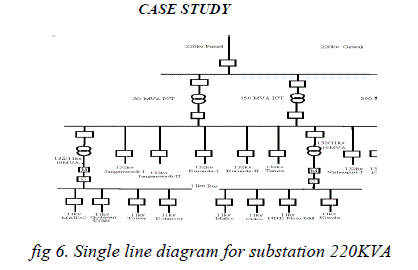 |
| Bay wise details of Equipment in 220- KV Sub Station |
| • Lightening Arrestor. |
| • Current transformer. |
| • Potential transformer. |
| • Line Isolator. |
| • Circuit Breaker’s |
| • Bus Isolator. |
| • Auxiliary Bus Isolator. |
| • Transformer. |
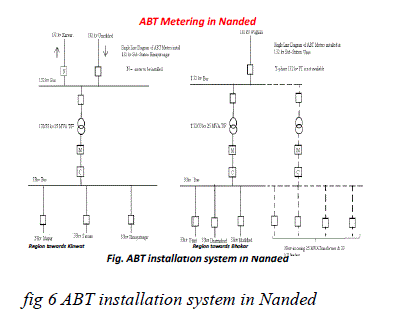 |
| ABT used in 132 KV SUBSTATION is |
| E- Watch of “secure meters” it is having |
| • Tabular view. |
| • Mimic view. |
| • Gauge view. |
| BY using above three views we can able to see trend of present power. |
| Parameter Monitor on ABT |
| • R- PH VOLTAGE |
| • R- PH CURRRUNT |
| • ACTIVE POWER |
| • REACTIVE POWER |
| • MWH IMPORT |
| • MWH EXPORT |
| • POWER FACTOR |
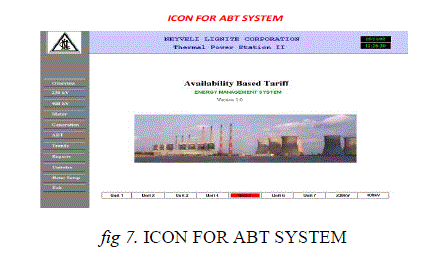 |
| Financial performance monitoring with respect to ABT |
| Reduction in IT infrastructure for future enhancements |
| Rich sets of reports and charts |
| Opportunities for corrective action on generation in next blocks to achieve PLF and positive UI |
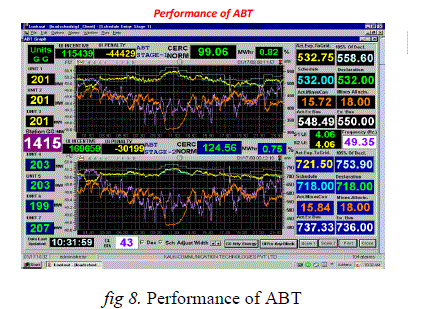 |
| In above simulation of real time system shows various parameters like. UI incentives .UI penalty. No’s of generating units. Export to grid. Scheduled power to grid. Plant wise generation. |
Advantages
|
| Accurate meter reading, no more estimates, improved billing, accurate profile classes and measurement classes, true costs applied. Improved security and tamper detection for equipment. Energy management through profile data graphs. Less accrued expenditure Transparency of “cost to read” metering improved procurement power though more accurate data - “de-risking” price. The benefits of smart metering for the customer. |
CONCLUSION
|
| Support for High Penetration of Renewable Energy, integrating a large proportion of renewable energy, due to that there is power fluctuations so maintain synchronization over, a large area. Power can be acquired using other paths if some lines have faults. The DGR enables the delivery of electricity to the destination cell, passing through several intermediate cells, by using an address and routing capabilities Both power and information are transmitted over the same physical line when PLC(power line communication) is used. The transition to the digital grid can be done gradually, so as to minimize capital expense. Furthermore, it can use existing transmission lines and also achieve higher capacity on those lines. |
| |
References
|
- Rikiya Abe, Member, IEEE, HisaoTaoka, Senior Member, IEEE, and David McQuilkin, Member, IEEE. “Digital Grid: Communicative ElectricalGrids of the Future”
- Nuclear energy outlook, 2008, The Potential for Renewable Energy in India – 2012.
- Solar Electricity cannot serve any significant fraction of U.S. or world electricity needs [Online]. Available: http://www1.eere.energy.gov/solar/myths.html “Smart grid” BP statistical review of world energy 2009, BP Inc., 2009, p. 6, 22,32,40.
- Survey of energy resources 2007, World Energy Council.
- Smartgrid.ieee.org/resources/public-policy / india.
- T. Brooks, “Wireless technology for industrial sensor and control networks,”in Proc. ISA/IEEE Sensors Ind. Conf., Rosemont, IL, Nov.2001, pp. 73–77.
- N. Pavlidou, A. J. Han Vinck, J. Yazdani, and B. Honary, “Power line communications: State of the art and future trends,” IEEE Commun.Mag., vol.41, no. 4, pp. 34–40, Apr. 2003.
- Majumder, “Caffery: Power line communications,” IEEE Potentials,vol. 23, no. 4, pp. 4–8, Oct Nov. 2004.
- J. Liu, B. Zhao, J. Wang, Y. Zhu, and J. Hu, “Application of power line communication in smart power consumption,” in Proc. IEEE Int. Symp.Power Line Commun. Its Appl., Mar. 2010, pp. 303 307.
- F. Issa, O. Devaux, E. Marthe, and F. Rachidi, “Influence of power switching on power line communications in medium voltage networks,”inProc.IEEE Int. Conf.Commun., 2004, vol. 1, pp. 114 117.
- N. Ginot, M. A. Mannah, C. Batard, and M.Machmoum, “Application of power line communication for data transmission over PWM network,”IEEETrans. Smart Grid, vol. 1, no. 2, pp. 178–185, Sep. 2010.
- Implementation of ABT (Availability Based Tariff) - its Treatment & Proceedings.
|